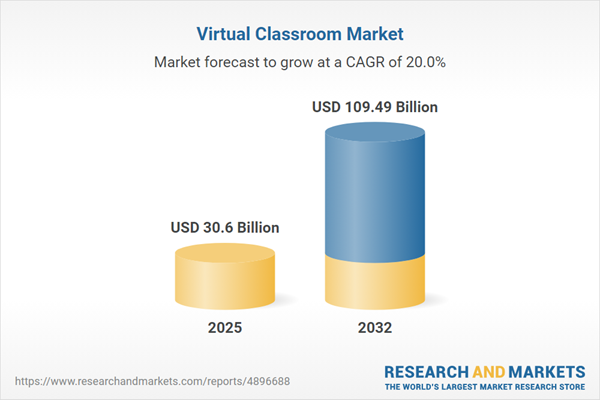Speak directly to the analyst to clarify any post sales queries you may have.
The virtual classroom market is transforming digital learning across industries, driven by technological advances, shifting stakeholder expectations, and rapid adoption of hybrid educational models.
Market Snapshot: Virtual Classroom Market Growth and Opportunity
The Virtual Classroom Market grew from USD 25.45 billion in 2024 to USD 30.60 billion in 2025. It is expected to continue growing at a CAGR of 20%, reaching USD 109.49 billion by 2032. This market demonstrates strong momentum, with institutions and enterprises worldwide investing in digital platforms that accommodate evolving learning needs, regulatory requirements, and regional connectivity infrastructure.
Scope & Segmentation
This report delivers a comprehensive analysis of the virtual classroom market, evaluating technologies, deployment models, industry use cases, and geographical presence. The segmentation includes:
- Product Type: Hardware, Services, Software
- Hardware: Networking Devices, Servers, Storage Devices
- Services: Consulting, Integration, Support
- Software: Licensed, Subscription
- End User Industry: BFSI, Healthcare, Manufacturing, Retail, Telecom
- Deployment Mode: Cloud, On Premise
- Americas: United States, Canada, Mexico, Brazil, Argentina, Chile, Colombia, Peru
- Europe, Middle East & Africa: United Kingdom, Germany, France, Russia, Italy, Spain, Netherlands, Sweden, Poland, Switzerland, United Arab Emirates, Saudi Arabia, Qatar, Turkey, Israel, South Africa, Nigeria, Egypt, Kenya
- Asia-Pacific: China, India, Japan, Australia, South Korea, Indonesia, Thailand, Malaysia, Singapore, Taiwan
Leading companies profiled include Zoom Video Communications, Microsoft, Alphabet, Cisco Systems, Adobe, Instructure, Blackboard, D2L, PowerSchool Group, and LogMeIn.
Key Takeaways
- Technology advances are reshaping virtual classroom solutions, enabling interactive and personalized digital learning across sectors.
- Artificial intelligence and immersive tools like augmented and virtual reality are driving pedagogical innovation and deeper learner engagement.
- Institutions and enterprises prioritize modular platform architectures, which support scalability, cross-system integration, and future-proof adaptability.
- Diverse industry needs require solutions tailored for data security, regulatory compliance, and specialty applications, particularly in finance, healthcare, and manufacturing.
- Regional trends reflect varying adoption drivers, such as broadband expansion in Latin America, localization in Asia-Pacific, and compliance in EMEA.
- Strategic vendor partnerships and end-to-end managed services are becoming standard, providing predictable outcomes and streamlined deployment for clients.
Tariff Impact
Recent United States tariff adjustments on virtual classroom hardware and technologies have led to higher import duties on key components, increasing production costs and shifting supply chain and pricing strategies. Providers are seeking operational resilience through nearshoring, renegotiated supplier agreements, and partnerships with local assemblers. Organizations increasingly evaluate managed services and alternative procurement models to offset these cost pressures.
Methodology & Data Sources
This report leverages a mixed-method approach, including primary interviews with industry experts and secondary research from academic, governmental, and industry sources. Quantitative analysis employed performance metrics from institutional deployments, while findings were peer-reviewed to ensure accuracy and relevance.
Why This Report Matters
- Enables senior decision-makers to benchmark technology adoption and identify growth opportunities across industries and regions within the virtual classroom market.
- Informs procurement and investment strategy with detailed segmentation, vendor profiles, and supply chain impact analysis tailored for evolving digital learning requirements.
- Provides actionable recommendations to enhance platform effectiveness, cybersecurity, and alignment with institutional objectives.
Conclusion
This analysis equips stakeholders to navigate complex digital transformation, maximize platform investments, and respond decisively to both opportunities and challenges in virtual classroom ecosystems.
Additional Product Information:
- Purchase of this report includes 1 year online access with quarterly updates.
- This report can be updated on request. Please contact our Customer Experience team using the Ask a Question widget on our website.
Table of Contents
3. Executive Summary
4. Market Overview
7. Cumulative Impact of Artificial Intelligence 2025
Companies Mentioned
The companies profiled in this Virtual Classroom market report include:- Zoom Video Communications, Inc.
- Microsoft Corporation
- Alphabet Inc.
- Cisco Systems, Inc.
- Adobe Inc.
- Instructure, Inc.
- Blackboard Inc.
- D2L Corporation
- PowerSchool Group LLC
- LogMeIn, Inc.
Table Information
| Report Attribute | Details |
|---|---|
| No. of Pages | 188 |
| Published | October 2025 |
| Forecast Period | 2025 - 2032 |
| Estimated Market Value ( USD | $ 30.6 Billion |
| Forecasted Market Value ( USD | $ 109.49 Billion |
| Compound Annual Growth Rate | 20.0% |
| Regions Covered | Global |
| No. of Companies Mentioned | 11 |









